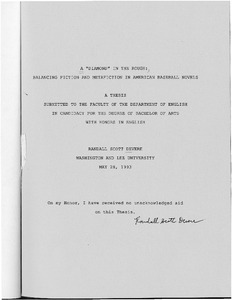| dc.rights.license | In Copyright | en_US |
| dc.creator | Devere, Randall Scott | |
| dc.date.accessioned | 2023-10-20T17:40:05Z | |
| dc.date.available | 2023-10-20T17:40:05Z | |
| dc.date.created | 1993 | |
| dc.identifier | WLURG038_Devere_thesis_1993 | |
| dc.identifier.uri | https://dspace.wlu.edu/handle/11021/36331 | |
| dc.description.abstract | For the novelists in this survey, however, baseball is not the only topic they explore. Traversing a vast time-frame, the six novels that I study in chronological order are linked by a common focus on the craft of writing about baseball as much as by baseball itself. Lardner's You Know Me Al (1914), Mark Harris's The Southpaw (1953) and Bang the Drum Slowly (1956), Robert Coover's The Universal Baseball Association, J. Henry Waugh, Prop. (1968), Roth's The Great American Novel (1972), and W.P. Kinsella's Shoeless Joe (1982) all contain distinct metafictional elements within their respective stories -- a narrative motif which grows as baseball fiction matures. By "metafiction," I mean the category of self-referential fiction which contemplates the actual process of writing fiction. In describing metafiction, critic Robert Scholes defines the essential characteristic of the "fabulator," or metafictional writer: "Delight in design, and its concurrent emphasis on the art of the designer . . ." Metafiction is self-reflexive literature that strives to "assault or transcend the laws of fiction . . . from within the fictional form." . . . As these stories demonstrate, the dialogue on baseball fiction is ongoing and ever-changing. Each of these novels is connected -- often consciously -- to the others: either through explicit allusion, or by symbolic and thematic similarities. As a result, the canon of baseball fiction can be viewed as a vast work-in-progress, stretching between writers and across decades. Just as Kinsella and Salinger come back to their "Field of Dreams," so we recognize the baseball diamond as a paradigm of balance amid a game of infinite possibility for action -- and interpretation. The search for narrative balance is the search for that diamond: what Donald Hall calls "a green island in a sea of change." [From Introduction] | en_US |
| dc.format.extent | 56 pages | en_US |
| dc.language.iso | en_US | en_US |
| dc.rights | This material is made available for use in research, teaching, and private study, pursuant to U.S. Copyright law. The user assumes full responsibility for any use of the materials, including but not limited to, infringement of copyright and publication rights of reproduced materials. Any materials used should be fully credited with the source. | en_US |
| dc.rights.uri | http://rightsstatements.org/vocab/InC/1.0/ | en_US |
| dc.subject.other | Washington and Lee University -- Honors in English | en_US |
| dc.title | A "Diamond" in the Rough: Balancing Fiction and Metafiction in American Baseball Novels | en_US |
| dc.type | Text | en_US |
| dcterms.isPartOf | WLURG038 - Student Papers | en_US |
| dc.rights.holder | Devere, Randall Scott | en_US |
| dc.subject.fast | Baseball stories, American | en_US |
| dc.subject.fast | Baseball -- Sports fiction | en_US |
| dc.subject.fast | Fiction -- Technique | en_US |
| local.department | English | en_US |
